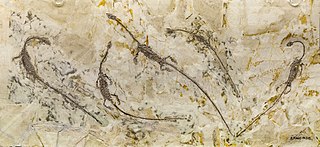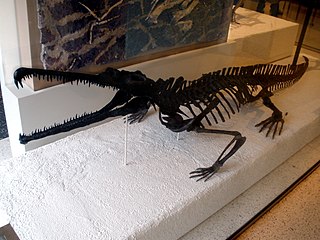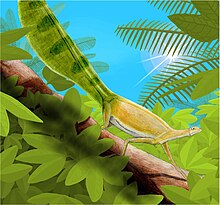
Tanystropheus is an extinct genus of archosauromorph reptile which lived during the Triassic Period in Europe, Asia, and North America. It is recognisable by its extremely elongated neck, longer than the torso and tail combined. The neck was composed of 13 vertebrae strengthened by extensive cervical ribs. Tanystropheus is one of the most well-described non-archosauriform archosauromorphs, known from numerous fossils, including nearly complete skeletons. Some species within the genus may have reached a total length of 6 meters (20 ft), making Tanystropheus the longest non-archosauriform archosauromorph as well. Tanystropheus is the namesake of the family Tanystropheidae, a clade collecting many long-necked Triassic archosauromorphs previously described as "protorosaurs" or "prolacertiforms".

Hyphalosaurus is a genus of freshwater aquatic reptiles, belonging to the extinct order Choristodera. They lived during the early Cretaceous period, about 122 million years ago. The genus contains two species, H. lingyuanensis and H. baitaigouensis, both from the Yixian Formation of Liaoning Province, China. They are among the best-known animals from the Jehol Biota, with thousands of fossil specimens representing all growth stages in scientific and private collections.

Avicephala is a potentially polyphyletic grouping of extinct diapsid reptiles that lived during the Late Permian and Triassic periods characterised by superficially bird-like skulls and arboreal lifestyles. As a clade, Avicephala is defined as including the gliding weigeltisaurids and the arboreal drepanosaurs to the exclusion of other major diapsid groups. This relationship is not recovered in the majority of phylogenetic analyses of early diapsids and so Avicephala is typically regarded as an unnatural grouping. However, the clade was recovered again in 2021 in a redescription of Weigeltisaurus, raising the possibility that the clade may be valid after all.

Hovasaurus is an extinct genus of basal diapsid reptile. It lived in what is now Madagascar during the Late Permian and Early Triassic, being a survivor of the Permian–Triassic extinction event and the paleontologically youngest member of the Tangasauridae. Fossils have been found in the Permian Lower and Triassic Middle Sakamena Formations of the Sakamena Group, where it is amongst the commonest fossils. Its morphology suggests an aquatic ecology.

Rutiodon is an extinct genus of mystriosuchine phytosaurs from the Late Triassic of the eastern United States. The type species of Rutiodon, Rutiodon carolinensis, encompasses a large number of skulls and assorted postcranial fossils discovered in the Cumnock Formation of North Carolina. Fossils referable to the species are also known from Pennsylvania, New Jersey, and Virginia. Rutiodon carolinensis is the most well-described species of phytosaur in eastern North America, though its validity as a natural taxon has been questioned. Some paleontologists also recognize a larger and more robust species, Rutiodon manhattanensis, which is known from teeth and postcranial fossils from New Jersey and Pennsylvania.

Icarosaurus is an extinct genus of kuehneosaurid reptile from the Late Triassic Lower Lockatong Formation of New Jersey. It is closely related to lizards and the tuatara. Based on a partial skeleton missing part of the tail, some ribs, a hand, and parts of the legs, it was a small animal, about 10 centimeters (4 in) long from the skull to the hips. Like its relative Kuehneosaurus, it was able to glide short distances using 'wings' consisting of highly elongated ribs covered with skin. These gliding membranes would have had a convex upper surface and a concave lower surface, thus creating a simple airfoil structure well-suited to gliding. This method of gliding is also seen in Coelurosauravus and the modern Draco, neither of which are closely related to Icarosaurus.

Hesperosuchus is an extinct genus of crocodylomorph reptile that contains a single species, Hesperosuchus agilis. Remains of this pseudosuchian have been found in Late Triassic (Carnian) strata from Arizona and New Mexico. Because of similarities in skull and neck anatomy and the presence of hollow bones Hesperosuchus was formerly thought to be an ancestor of later carnosaurian dinosaurs, but based on more recent findings and research it is now known to be more closely related to crocodilians rather than dinosaurs.

Nicrosaurus (/nɪkroʊˈsɔrəs/) is an extinct genus of phytosaur reptile existing during the Late Triassic period. Although it looked like a crocodile, it was not closely related to these creatures, instead being an example of parallel evolution. The main difference between Nicrosaurus and modern crocodiles is the position of the nostrils – Nicrosaurus's nostrils, or external nares, were placed directly in front of the forehead, whereas in crocodiles, the nostrils are positioned on the end of the snout. A 2013 study has also found that ilium of Nicrosaurus is quite distinctive from all other phytosaurs.

Doswellia is an extinct genus of archosauriform from the Late Triassic of North America. It is the most notable member of the family Doswelliidae, related to the proterochampsids. Doswellia was a low and heavily built carnivore which lived during the Carnian stage of the Late Triassic. It possesses many unusual features including a wide, flattened head with narrow jaws and a box-like rib cage surrounded by many rows of bony plates. The type species Doswellia kaltenbachi was named in 1980 from fossils found within the Vinita member of the Doswell Formation in Virginia. The formation, which is found in the Taylorsville Basin, is part of the larger Newark Supergroup. Doswellia is named after Doswell, the town from which much of the taxon's remains have been found. A second species, D. sixmilensis, was described in 2012 from the Bluewater Creek Formation of the Chinle Group in New Mexico; however, this species was subsequently transferred to a separate doswelliid genus, Rugarhynchos. Bonafide Doswellia kaltenbachi fossils are also known from the Chinle Formation of Arizona.

Megalancosaurus is a genus of extinct reptile from the Late Triassic Dolomia di Forni Formation and Zorzino Limestone of northern Italy, and one of the best known drepanosaurids. The type species is M. preonensis; a translation of the animal's scientific name would be "long armed reptile from the Preone Valley."

Drepanosaurus is a genus of arboreal (tree-dwelling) reptile that lived during the Triassic Period. It is a member of the Drepanosauridae, a group of diapsid reptiles known for their prehensile tails. Drepanosaurus was probably an insectivore, and lived in a coastal environment in what is now modern day Italy, as well as in a streamside environment in the midwestern United States.

Drepanosaurs are a group of extinct reptiles that lived between the Carnian and Rhaetian stages of the late Triassic Period, approximately between 230 and 210 million years ago. The various species of drepanosaurid were characterized by specialized grasping limbs and often prehensile tails, adaptions for arboreal (tree-dwelling) and fossorial (digging) lifestyles, with some having also been suggested to be aquatic. Fossils of drepanosaurs have been found in Arizona, New Mexico, New Jersey, Utah, England, and northern Italy. The name is taken from the family's namesake genus Drepanosaurus, which means "sickle lizard," a reference to their strongly curved claws.

Mecistotrachelos is an extinct genus of gliding reptile from the Late Triassic of Virginia. It is generally interpreted as an archosauromorph, distantly related to crocodylians and dinosaurs. The type and only known species is M. apeoros. This specific name translates to "soaring longest neck", in reference to its gliding habits and long neck. This superficially lizard-like animal was able to spread its lengthened ribs and glide on wing-like membranes. Mecistotrachelos had a much longer neck than other gliding reptiles of the Triassic such as Icarosaurus and Kuehneosaurus. It was probably an arboreal insectivore.
The Triassic Lockatong Formation is a mapped bedrock unit in Pennsylvania, New Jersey, and New York. It is named after the Lockatong Creek in Hunterdon County, New Jersey.

Vancleavea is a genus of extinct, armoured, non-archosaurian archosauriforms from the Late Triassic of western North America. The type and only known species is V. campi, named by Robert Long & Phillip A Murry in 1995. At that time, the genus was only known from fragmentary bones including osteoderms and vertebrae. However, since then many more fossils have been found, including a pair of nearly complete skeletons discovered in 2002. These finds have shown that members of the genus were bizarre semiaquatic reptiles. Vancleavea individuals had short snouts with large, fang-like teeth, and long bodies with small limbs. They were completely covered with bony plates known as osteoderms, which came in several different varieties distributed around the body. Phylogenetic analyses by professional paleontologists have shown that Vancleavea was an archosauriform, part of the lineage of reptiles that would lead to archosaurs such as dinosaurs and crocodilians. Vancleavea lacks certain traits which are present in most other archosauriforms, most notably the antorbital, mandibular and supratemporal fenestrae, which are weight-saving holes in the skulls of other taxa. However, other features clearly support its archosauriform identity, including a lack of intercentra, the presence of osteoderms, an ossified laterosphenoid, and several adaptations of the femur and ankle bones. In 2016, a new genus of archosauriform, Litorosuchus, was described. This genus resembled both Vancleavea and more typical archosauriforms in different respects, allowing Litorosuchus to act as a transitional fossil linking Vancleavea to less aberrant archosauriforms.

Weigeltisauridae is a family of gliding neodiapsid reptiles that lived during the Late Permian, between 259.51 and 251.9 million years ago. Fossils of weigeltisaurids have been found in Madagascar, Germany, Great Britain, and Russia. They are characterized by long, hollow rod-shaped bones extending from the torso that probably supported wing-like membranes. Similar membranes are also found in several other extinct reptiles such as kuehneosaurids and Mecistotrachelos, as well as living gliding lizards, although each group evolved these structures independently.

Protorosauria is an extinct, likely paraphyletic group of basal archosauromorph reptiles from the latest Middle Permian to the end of the Late Triassic of Asia, Europe and North America. It was named by the English anatomist and paleontologist Thomas Henry Huxley in 1871 as an order, originally to solely contain Protorosaurus. Other names which were once considered equivalent to Protorosauria include Prolacertiformes and Prolacertilia.

Tanytrachelos is an extinct genus of tanystropheid archosauromorph reptile from the Late Triassic of the eastern United States. It contains a single species, Tanytrachelos ahynis, which is known from several hundred fossil specimens preserved in the Solite Quarry in Cascade, Virginia. Abundant fossils of Tanytrachelos are found in a series of lakebed sediments that were deposited over the course of about 350 thousand years in a lake which existed approximately 230 million years ago. Some fossils are very well-preserved and include the remains of soft tissues. Tanytrachelos is the most likely trackmaker of the ichnogenus Gwyneddichnium.

Avicranium is a genus of extinct drepanosaur reptile known from the Chinle Formation of the late Triassic. The type species of Avicranium is Avicranium renestoi. "Avicranium" is Latin for "bird cranium", in reference to its unusual bird-like skull, while "renestoi" references Silvio Renesto, a paleontologist known for studies of Italian drepanosaurs.
Gwyneddichnium is an ichnogenus from the Late Triassic of North America and Europe. It represents a form of reptile footprints and trackways, likely produced by small tanystropheids such as Tanytrachelos. Gwyneddichnium includes a single species, Gwyneddichnium major. Two other proposed species, G. elongatum and G. minore, are indistinguishable from G. major apart from their smaller size and minor taphonomic discrepancies. As a result, they are considered junior synonyms of G. major.



























